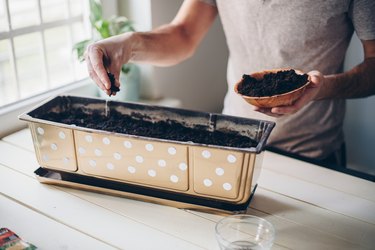
Even avid gardeners don't always have the room to build a greenhouse or plant a garden. Don't let space stop you from pursuing your passion; turn a spare room into a homemade indoor greenhouse. Not only does this provide you with a space to start seedlings for hanging planter or balcony use, it gives you room to grow summer produce, herbs and with enough light, dwarf fruit trees, which will ensure that you'll have fresh fruits and veggies year-round.
Set Up the Indoor Garden Room
Video of the Day
First things first, decide what you're going to plant. Fruit trees require full sun or 12 to 16 hours daily exposure to grow lights. Some smaller vegetable and herbs tolerate less sun and partial shade, making them easier to grow indoors. Once you've determined the available light and space, set up your indoor greenhouse room.
Video of the Day
Step 1: Select a Gardening Room
Choose an indoor garden room with its own thermostat and plenty of south-facing windows. Rooms with southwest-, southeast-, east- or west-facing windows will do as well. Maintain the room's temperature at between 65 and 75 degrees.
Step 2: Protect the Floor
Lay down plastic sheeting or a large plastic drop cloth to protect the flooring. Use painter's tape to secure the plastic to the walls around the perimeter of the room.
Step 3: Set Up Seedling Tables
Set up tables for your seedlings. Place them against walls away from the windows.
Step 4: Add Trays and Grow Lights
Place some large, plastic flood trays on the tables and bookend each table with free-standing grow lights. This provides a warm, controlled atmosphere for your seedlings.
Step 5: Put on Safety Gear
Put on gloves and safety goggles to protect your eyes and skin before you prepare the planting containers. Wear a dust mask when working with potting mixes and garden amendments.
Step 6: Prepare Planting Containers
Cut 2-liter soda bottles in half with a utility knife. Alternately, use recycled plastic tubs or biodegradable paper or peat pots.
Step 7: Add Drain Holes
Poke holes in the bottom half of each container for drainage. Place the containers on the flood trays.
Step 8: Fill With Seed-Starting Mix
Fill the planting containers with moist sterile seed-starting mix. Plant one to three seeds in each container, according to the seed packet instructions.
Step 9: Water the Mix
Water the seed-starting mix every other day to keep the seeds moist. Alternately, cover the containers with plastic wrap. As seedlings sprout and grow, you can transplant them to larger pots.
Add Additional Plants
Once your seedlings are thriving in your bedroom grow room, consider adding more plants, such as tropicals, dwarf fruit trees, herbs and flowers. Arrange the plant tables and containers for larger plants according to their need for light and accessibility when you're working in your plant room.
Step 1: Add More Flowerpots
Fill additional flowerpots with rich potting soil up to about 1 inch below the rims. Dig holes that match the size of the root ball to be placed in each pot.
Step 2: Buy More Plants
Plant purchased seedlings of tropical produce, flowers, herbs and trees in terra cotta or plastic pots. The pots should be at least 8 inches wide and 6 to 10 inches deep so that the seedlings can spread their roots. Dwarf fruit trees need containers at least 18 inches wide and deep.
Step 3: Transplant the New Plants
Untangle the roots of each plant before setting them in the holes. Simply pull the sides of the root balls in opposite directions. Some of the roots will break. Don't worry; they'll heal and branch out once planted.
Step 4: Cover and Water
Cover the roots with about 1 inch of soil; add water until the soil is moist. About 16 ounces of water should be adequate.
Step 5: Put the Plants Near Windows
Place the planted pots in the flood trays on tables or, in the case of larger plants, on the floor near the windows. The plants should get plenty of sun during the day. Plants requiring less or indirect light can be placed on tables near the center of the room. Alternately, add sheer curtains to diffuse the bright sunlight.
Step 6: Add Extra Humidity
Create a humid atmosphere in your indoor garden room in one of three ways. First, you can spritz each of your plants every other day with room temperature water in a spray bottle. Second, you may set bowls of water around the room, letting them vaporize into the air. Third, you may place river rocks in each plant's flood tray and cover the rocks with water.